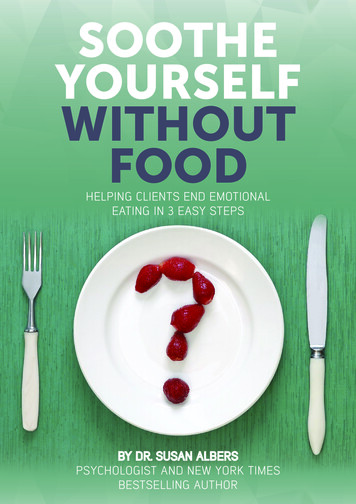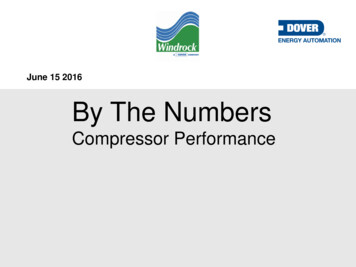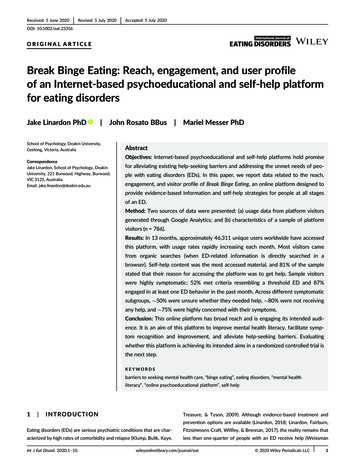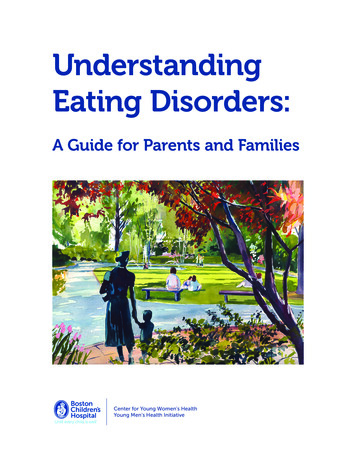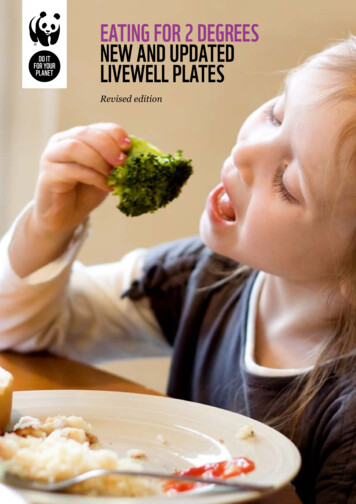
Transcription
Eating for 2 degreesnew and updatedLivewell PlatesRevised edition
ContributorsGerard Kramer, Bart Durlinger,Lody Kuling, Willem-Jan van Zeist,Hans Blonk, Roline Broekema,Sarah HalevyDesignmadenoise.comAugust 2017Note on revised editionAs a result of a query about inconsistencies betweenthe carbon footprint breakdown and the figuresin the composition tables presented in Eating for 2degrees – new and updated Livewell Plates (May 2017),a miscalculation error has been identified which ledto incorrect values across the Livewell Plates beingpublished. Although the suggested consumption ofvarious products is affected by this, in particular beefand veal, poultry and processed meat, it does notaffect the overall conclusions of the report.Blonk ConsultantsAbout WWFWWF is the world’s leading independent conservationorganisation. We’re creating solutions to the mostimportant environmental challenges facing theplanet. We work with communities, businesses andgovernments in over 100 countries to help people andnature thrive. Together, we’re safeguarding the naturalworld, tackling dangerous climate change and enablingpeople to use only their fair share of natural resources.Food is at the heart of many key environmental issuesWWF works on. Growing, producing and importingfood contributes substantially to climate change. It’s adriving force behind habitat and biodiversity loss. Andit’s a huge drain on water resources. That’s why helpingto develop a sustainable food system for healthypeople and a healthy planet is one of WWF’s priorities.Find out more about our work at wwf.org.uk/foodAbout BlonkBlonk Consultants helps companies, governments andcivil society organisations put sustainability into practice.Our team of dedicated consultants works closely withour clients to deliver clear and practical advice basedon sound, independent research. To ensure optimaloutcomes we take an integrated approachthat encompasses the whole production chain.www.blonkconsultants.nl John Daniels / WWFCover photo Kelly Sillaste / Getty Images / WWF
contentsPreface5Foreword7Executive summary.8Glossary, acronyms and abbreviations. 141Introduction. 162Objectives and research questions.173 Methodology overview. 18Steps in deriving healthy and sustainable diets by optimisation. 18Consumer groups. 18Constraints. 18Environmental constraints. 18Reduction of GHG impact (carbon footprint). 19Limits for land occupation. 19Nutritional requirements (defining upper and lower limits). 19Constraint on fish.20Food products in the optimisation.20Product categories.20Environmental impacts of food products.20Nutritional data on food products.20Current diets. 21Selection of optimisation algorithm and calibration. 214Results.22Livewell Plates.22Adults 2020 and 2030. 22Comparison to the Eatwell Guide.28Adolescents 2030.30Elderly 2030. 32Vegans 2030.34Cost of Livewell Plates. 36Historical trends in diets. 375 Conclusions.42
Annex 1: Definition of Livewell GHG reduction requirements. 45Target for GHG emissions. 45Land occupation. 45Annex 2: Data sources health and nutrition.46Current diets.46Nutrient requirements. 47Food-based dietary guidelines.48Food composition.49Costs.49Historical trends.49Annex 3: LCA methodology and data.50Scope.50Functional unit. 53System boundaries. 53Included impacts. 54GHG emissions. 54GHG emissions by land-use change. 54Land occupation. 54Impact on freshwater use. 54Compliance to life cycle impact assessment methodologies. 54Intended use. 54Limitations. 54Crop rotation. 54Surface albedo change. 54Regionalisation. 55Data variation. 55Transport from supermarket to the consumer home. 55Life cycle inventory. 55Agri-footprint. 55Life cycle inventory databases developed for the Dutch National Institutefor Public Health and the Environment. 55Other food products. 55Distribution centre. 55Supermarket. 56Consumer phase. 56Food losses through the life cycle. 56Transport through the life cycle. 56Annex 4: Optimisation. 57Annex 5: Livewell meeting report.58Livestock.58Horticulture. 59Business. 61Other.62Annex 6: Food and WWF policy areas. 63Water . 63Forests. 65Seafood. 67Meat.68Soy.69Literature. 70
Eating for 2 degrees – new and updated Livewell Plates5PrefaceThe newly modelled Livewell Plates presented in thisreport illustrate the dietary changes we need to makeby 2020 and 2030 in order to keep the average globaltemperature rise well below 2 degrees, as agreed at theParis climate conference in December 2015.Below are the key elements of our research framework.The Paris AgreementReduction from the food sectorThe Paris Climate Change Agreementadopted at the Conference of the Partiesin December 2015 (COP21) entered intoforce on 4 November 2016. This landmarkagreement aims to reduce man-madegreenhouse gas (GHG) emissions to a levelthat limits the global average temperaturerise to well below 2 degrees compared topre-industrial levels, with an aspirationalgoal of 1.5 degrees. These targets have beenagreed by the international community andendorsed by companies, and their policieswill be geared towards achieving them.To analyse the changes required in thefood sector we’ve assumed it needs tomake the same level of contribution asthe rest of the economy, in other words areduction in emissions of 60%. Rather thana prescriptive target, this is an exerciseto help start the conversation aboutmitigation efforts within the food sector.Changes to the food system will need to bepart of the solution. WWF is committedto working with all stakeholders withinthe food sector to understand how it cancontribute and what steps need to be takento keep the rise well below 2 degrees.UK Carbon budgetsThe Paris Agreement commits all partiesto build on their efforts to keep globalwarming well below 2 degrees, and aimto achieve 1.5 degrees. In the UK, theCommittee on Climate Change has advisedthe government to reduce territorialemissions by 61% from 1990 levels. For thisreport we’ve rounded this down to 60%.It’s important to note that thisscenario should be considereda conservative estimate of thecontribution required to uphold theParis Agreement i.Within the food system mitigationefforts can be split between producersand consumers. Producers can improveresource efficiency and reduce emissions,while consumers can adopt a climatesmart diet such as the Livewell dietpresented in this report. Our core analysisfocuses on consumptionii.Split between consumptionand productionIn order to establish the necessaryemissions reductions from the foodsystem – and taking into account a lackof research relating to consumption’s ‘fairshare’ in achieving this – we’ve developedthree scenarios: A 50/50 split between consumptionand production, which leads to a 30%reduction in consumption relatedGHG emissions; A 70/30 split between consumptionand production, which leads to a 42%reduction in consumption related GHGemissions; and A 30/70 split between consumptionand production, which leads to a 18%reduction in consumption relatedGHG emissions.i K carbon budgets are currently aiming for 2 degrees and will need to be strengthened to achieve theU‘well below’ 2 degrees target.ii he analysis is based on projected food consumption in the UK, which includes a mix of imported goodsTand domestic production. For formal accounting purposes, the emissions reductions related to importedfood would be accounted for in the exporting countries, whereas the emissions reductions of domesticfood production would be accounted for across the economic sectors considered in the life cycle analysis.
Eating for 2 degrees – new and updated Livewell PlatesWhile our reduction targets were 25%by 2020 compared to 1990 levels inLivewell: a balance of healthy andsustainable diets and our LiveWell forLIFE project (in line with WWF’s OnePlanet Food programme goal), we needto work within the global context of theParis Agreement when developing ournew Livewell Plates. We’ve also includeda scenario approach in the hope that it’llstart a discussion on how best to approachthe split between consumption andproduction in achieving the reductionswe need.iii6Land occupationApart from global warming, loss ofbiodiversity is the other major globalenvironmental concern addressed in thisreport. Loss of biodiversity is closely linkedto the conversion of natural habitats, suchas tropical rainforest being cleared foragricultural land. The world’s forests andother natural habitats are also importantcarbon sinks.Our model works on the basis that theadoption of the Livewell Plates brings noincrease in land converted for agriculture– in particular grassland and cropland,and especially in vulnerable regions suchas Latin America and Southeast Asiaiii. Theprojected growth in the world’s populationmeans that the share of availableagricultural land for each individual willdecrease over time. est PC, Gerber JS, Engstrom PM, et al. (2014) Leverage points for improving global food security and theWenvironment. Science (80-. ). 345, 325–328. Sarah Halevy
Eating for 2 degrees – new and updated Livewell Plates7ForewordWhen we first started working on sustainable dietsin 2010, we were told it was confusing and evenimpossible to define a diet that linked health andenvironmental outcomes.We questioned this perceived wisdom, andafter speaking with leading academics wedecided to see what we could do. This lead toLivewell – a healthy, sustainable diet that’sgood for people and the planet. Livewellwas based on the government’s own healthyeating advice, the Eatwell Plate, anddemonstrated how a nutritious diet that canalso lead to a reduction in carbon emissionsfrom the food supply chain.Duncan WilliamsonFood Policy Manager, WWFSince then sustainable diets have movedup the agenda. It’s no longer niche. EatingBetter champions coordinated civil societywork; the Eat Foundation has arrived andjoined us in the call to make sustainablediets mainstream. We have The ProteinChallenge 2040 and the World ResourceInstitute’s work on sustainable diets. Evenretailers and the food service sector aretaking an active role – just look at Sodexo’sGreen and Lean offer!External development and feedback fromexpert stakeholders – including farmers,business leaders and health experts –meant it was time to update our Livewellwork. When identifying the environmentalconstraints for the research it was clearto us that the basic tenet would have to bethe Paris Agreement. We’ve also includedwater and land metrics for the first time.And we’ve looked at diets for different ages:adults, teenagers and the elderly. We’veeven produced a Plate for vegans. Thisshows the flexibility of sustainable diets. Wecan eat a huge variety of dishes, includingmeat and cake if we so wish.Of course, our work doesn’t stop here.As policy, science and evidence progress,we’ll include further nutritional andenvironmental constraints to our research.From an environmental point of view, thePlates presented in this report illustrate theabsolute minimal dietary changes neededto reach a 2 degree target. We need tighterenvironmental constraints if we want toreach the well below 2 degrees target, oreven the aspirational 1.5 degree target.And we want to continue to illustrate thatsustainable diets are appropriate for allage groups across the globe. So we hope todevelop additional Plates. This may wellinclude one for infants and primary schoolchildren as well as country specific Plates inthe global North and South.This work is about more than what weeat. It is about linking consumption toproduction. That’s why we advocate the roleof credible certification – including MSC/ASC, RTRS and Fairtrade – as a way toidentify how our food has been produced.We need to respect the rights of workersas well as ensure that sustainable diets areavailable, accessible and affordable for allpeople. We need producers to get involvedand recognise that this agenda supportstheir long-term goals.That’s why we need the UK governmentto engage. It is not about nanny stateism(after all the government has a hand inall our food decisions from farming andfishing policy, to taxes, nutritional adviceand public procurement). It about joinedup policy making that puts health andsustainability at the heart of our food,farming and fishing industries. WithBrexit we have a unique opportunity torefresh the food sector to deliver healthand environmental outcomes. This is anew frontier for UK food. We know dietscross boundaries, we’ve seen the spread thewestern diet and its associated problems.Now’s the opportunity for the UK to lead theway delivering a sustainable food system.We’ve had a lot of support developingthis work. Thank you too everyone whoparticipated in our expert consultation,we have taken your advice on board. Anda special thank you to Tara Garnett,Wendy Russell and Tim Lang for reviewingthis work.
Eating for 2 degrees – new and updated Livewell Plates8Executive SummaryOverviewBackgroundThis paper is a summary of the researchcarried out in 2016 by Blonk Consultantsto update WWF’s work on sustainable foodconsumption. Our Livewell work startedin 2010 in response to scientific evidencedemonstrating the need for a systemicapproach to a sustainable food system.In 2011, we published our first Livewellreport Livewell: a balance of healthy andsustainable food choices, which includedthe Livewell Plate.Globally, 20% of total direct carbonemissions are from food and agriculture.When land-use change is factored in, thisfigure rises to 30%. Around 70% of all freshwater withdrawn is used for agriculturalirrigation, which in many cases has a majorimpact on water quality. And agriculture isthe most significant cause of deforestation– and hence loss of biodiversity – aroundthe world.Livewell Plates are representativediets that meet national nutritionalrequirements while reducing theenvironmental footprint of the foodsystem that produces them: they’rediets that are good for both peopleand planet.The research presented in Eating for2 degrees aimed to produce updatedversions of the Livewell Plate by usingadditional environmental criteria – such aswater use and land footprint – and toproduce individual Plates for four separategroups: adults, adolescents, the elderly andvegans. Whereas the original Livewell Platewas for adult women only, each Platepresented here is an average Plate for eachdemographic. They include the latestnutritional data, environmental metrics andan estimate of costs; and are compared tocurrent average diets for each demographic.Historical changes in eating habitssince 1961 are also analysed and theconsequent health and environmentalimpacts are mapped.What we eat and how it’s produced haveconsequences for the whole planet. Bychanging our diets and by improvingproduction efficiency in the food systemwe can make a major contribution tothe environmental performance of thefood system. Indeed, now that the ParisAgreement is in force we have bindingcommitments to reduce carbon emissions,and in the UK, the Committee on ClimateChange has advised the government toreduce territorial emissions by 61% from1990 levels by 2030. For this report we’verounded this down to 60%.Changes in the food system will have tobe part of the solution, and this reportassumes the food sector needs to makethe same level of contribution as the restof the economy as a whole. Mitigationefforts can be divided between producersand consumers, and – while we’ve alsoexplored other proportions – we’ve basedour modelling on a 50/50 split. Our coreanalysis focuses on consumption.As will be described in detail below,Blonk Consultants found that it’s indeedpossible to eat a sustainable, nutritiousdiet that contributes to the future healthof the planet and its population, withoutsignificant increases in costs.Globally, 20% of total directcarbon emissions are from foodand agriculture.
Eating for 2 degrees – new and updated Livewell Plates9ProcessBlonk Consultants carried out the analysisusing Optimeal 2.0, a bespoke optimisationtool that uses quadratic programming.In simple terms, it works by taking theoverall nutritional requirements of a givengroup, then finding a division of foodproducts that will meet these needs whilealso respecting various environmentalconstraints agreed by the research team(limited carbon footprint in line withnational reduction targets, equal individualshares of the world’s current agriculturalland, and so on). A detailed account isgiven below.A great amount of rigour was requiredwhen creating the databases on whichthe optimisation process depends. Fromcreating food product groups to calculatingnutritional outputs and the environmentalfootprints of product life cycles, ourresearchers used a wide range of approvedsources to build realistic and measurablesolutions that reflect the complex andinterlinked nature of today’s food system.The goal was to create Livewell Plateswhose composition was as close as possibleto the current average diet for each groupin the UK. A range of other metrics – fromcost to blue water footprint – was alsodetailed in each case.ResultsWe updated the 2020 Plates and createdfour new Livewell Plates for 2030. Allthe Plates meet national nutritional andenvironmental needs, without significantcost increases.While each of the Plates is differentand is described individually below, it’spossible to make some general points ontheir composition.Carbon footprintFirst, the carbon footprint of the averagediet has reduced considerably since 1990 –almost exclusively through improvementsin production. When nutritionalrequirements alone are fed into theLivewell Plate model, the carbon footprintof each diet falls further. The vegan Platehas the lowest carbon footprint of all.Carbon footprint (kgCO2eq/day)Breakdown of carbon footprint (GHG emissions) of the current UK diet and adult Livewell PlatesCurrent dietLivewell 2020Livewell 2030
Eating for 2 degrees – new and updated Livewell PlatesChanges in dietNotable increases are clear in meatreplacers (such as soy and Quorn);legumes, nuts and oilseeds; fats andoils; vegetables; and aquaculture fish.Fish is nutritionally important, but forenvironmental reasons the optimisationmodel didn’t permit an increase in wildcaught fish. Aquacultured fish, like salmon,is therefore increased in order to meetthe Eatwell Guideiv requirement of twoservings of 140g of fish per week. The typesof fish in the Livewell Plate are all availablewith either a Marine Stewarship Council(MSC) or Aqualculture Stewarship Council(ASC) label.The most obvious difference betweenall Livewell Plates and current diets is asignificantly lower amount of meat. Beefand lamb have high carbon footprintprimarily related to the enteric fermentationin the gut, leading to methane emissions.Reducing beef and lamb is therefore far themost less effective.However, in order to allow beef and lamb toremain on the Plate all other meat groupsare also reduced. This reduction in meatsupports our Livewell principle (see below)that people need to moderate their meatconsumption – red and white – and noteat more white meat to compensate for thereduction of red meat.Cheese is reduced, but other dairy – one ofthe most important sources of iodine in theUK diet – increases on the adult Plates. Thiswas also the case in the original LivewellPlate for the UK.iv10The maximum limit of 5% of total energyfrom added sugar set by the ScientificAdvisory Committee on Nutrition provedchallenging and caused a a significantreduction of sugar and confectionery. Butthere is an increase of food in the snacks,desserts and other food category. It’simportant to note here that in spite ofthe UK government’s levy on the saleof sugary drinks (to be implemented byApril 2018) and a target to reduce theamount of sugar in food products by 20%,a large amount of hidden added sugarremains in our everyday products. This willneed to be tackled if we want to reduce theoverall amount of sugar we consume on adaily basis.It’s also important to remember thatevery change on our plates has real-worldconsequences, and the results reflect howcomplex this can be. So while reducingmeat consumption means less grasslandis needed for pasture and less cropland isneeded to grow animal feed (such as soyand maize), it may also mean that morecropland is needed to provide increasedamounts of legumes, or vegetable oil.These in turn may require increased landoccupation and produce a higher blue waterfootprint – but there’s a huge differencebetween repurposing existing agriculturalland and clearing rainforest to create more.In short, all these results need to be seenin their overall context to truly reflect thecomplex inter-relationships that define theconsumption and production of food. he Eatwell Guide (formerly the Eatwell Plate) is a visual communications tool created by the UK FoodTStandards Agency to promote nutritionally healthy diets well-guide
Eating for 2 degrees – new and updated Livewell Plates11CurrentAdult 2030CurrentAdolescent 2030CurrentElderly 2030CurrentVEGAN 2030Pie-charts of the composition of the current adult diet (NDNS) and the adult Livewe
Livewell - a healthy, sustainable diet that's good for people and the planet. Livewell was based on the government's own healthy eating advice, the Eatwell Plate, and demonstrated how a nutritious diet that can also lead to a reduction in carbon emissions from the food supply chain. Since then sustainable diets have moved up the agenda.


